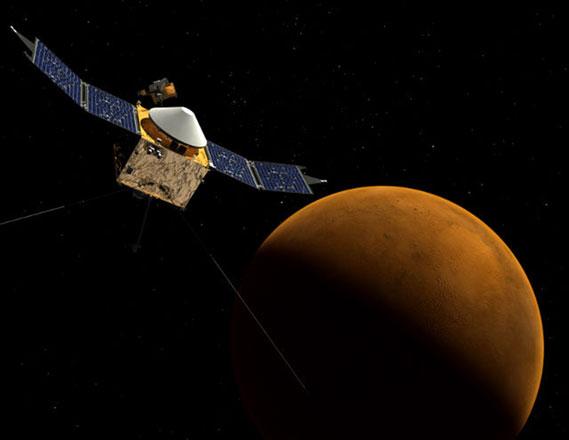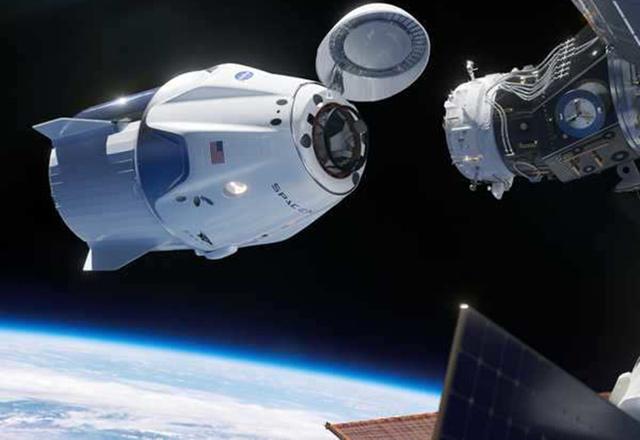You are here
NASA unveils [some] missing pieces in journey to Mars
By AFP - Oct 11,2015 - Last updated at Oct 11,2015

A file picture of an undated artist’s concept shows the MAVEN spacecraft orbiting Mars (Photo courtesy of NASA)
MIAMI — In the Hollywood movie “The Martian” an American astronaut survives on Mars against all odds, but in reality NASA admits that huge obstacles remain before humans can reach the Red Planet.
NASA outlined the many steps ahead in a 36-page document that calls the problems “solvable” but steers clear of saying how much money is needed or when to expect an astronaut mission to Mars.
The strategy was released to the public late Thursday ahead of talks with Congress about budgets for space exploration and before a major international meeting of the space industry in Jerusalem next week.
Astronauts who journey to Mars could spend three years in deep space, where radiation is high and so are the risks of cancer, bone loss and immune problems, said the document, called “NASA’s Journey to Mars: Pioneering Next Steps in Space Exploration.”
“The journey is worth the risk,” it said, calling Mars “an achievable goal” and “the next tangible frontier for expanding human presence”.
But John Rummel, senior scientist at the SETI Institute, said the document contains “curious shortcomings”, noting that it only mentions the terms “food” and “air” once, without elaborating on how astronauts will grow food in space to survive.
It also ignores the fundamental issue of contamination risk to any potential tiny life forms on Mars from humans, or vice versa, Rummel told AFP.
“Without sufficient care, Earth contamination could be misread as Mars life,” he warned.
At a Capitol Hill hearing Friday, Republican Congressman Lamar Smith lamented the White House’s budget proposals in recent years, which have cut funding for Mars exploration — including a $440 million cut to Mars programmes in fiscal year 2016 — despite widespread support from the public and lawmakers on both sides of the aisle.
Smith, who chairs the House Science, Space and Technology Committee, also lashed out at NASA’s Mars strategy.
“This proposal contains no budget, it contains no schedule, no deadline. It is just some real pretty photographs and some nice words,” he thundered.
“That is not going to get us to Mars.
“It is actually a journey to nowhere until we have that budget.”
Closer than ever?
NASA administrator Charles Bolden said in a statement that the US space agency is “closer to sending American astronauts to Mars than at any point in our history”.
Bolden, a former astronaut, said he looked “forward to continuing to discuss the details of our plan with members of Congress, as well as our commercial and our international partners, many of whom will be attending the International Astronautical Congress next week”.
The path ahead is divided into three stages, the first of which is already under way with testing and experiments at the International Space Station.
The second phase, called “Proving Ground”, begins in 2018 with the first launch of the new deep-space capsule Orion atop the most powerful rocket ever built, known as the Space Launch System, or SLS.
After that, the space agency plans to practice other missions in the area of space between the Earth and Moon, or in the Moon’s orbit, known as cislunar space.
These include sending a robotic spacecraft in 2020 to lasso a boulder from a near-Earth asteroid and ferry it to an area in deep space that astronauts can investigate.
“NASA will learn to conduct complex operations in a deep-space environment that allows crews to return to Earth in a matter of days,” said the report.
The third phase involves living and working on Mars’ surface and in transiting spaceships “that support human life for years, with only routine maintenance”, as well as “harvesting Martian resources to create fuel, water, oxygen, and building materials”.
NASA gave no dates or details for this phase in the report, though one graphic mentioned “human missions to Mars vicinity in 2030+.”
The investments outlined in each of the three phases “are affordable within NASA’s current budget”, the report said.
Complex problem
As NASA presses farther into space, the agency acknowledged that the problems will grow more complex.
“Future missions will face increasingly difficult challenges associated with transportation, working in space and staying healthy,” said the report.
NASA also said it needs to develop adequate space suits to protect against the hazards of deep-space exploration and must test advanced solar electric propulsion to power spacecraft efficiently.
The spectacular sky-crane powered landing that allowed the Curiosity rover to touch down on Mars in 2012 must be completely revamped for a human-scale landing, which would be 20-30 times heavier.
A vehicle to lift humans from the surface of Mars into Mars’ orbit is also needed, and is considered “critical to crew survival.”
“NASA will have to learn new ways of operating in space,” said the report.
“Overcoming these challenges will be essential on the journey to Mars.”
Related Articles
A new US space capsule, Orion, circled the Earth twice before plunging into the ocean Friday in a flawless test flight that opened a new chapter in human deep space travel.
AMMAN — The head of the US National Aeronautics and Space Administration (NASA) told Jordanian space enthusiasts about a planned mission to
WASHINGTON — Four astronauts carried into orbit by a SpaceX Crew Dragon boarded the International Space Station on Tuesday, the first of wha
















